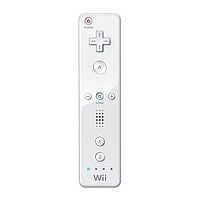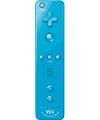Wii Remote: Difference between revisions
No edit summary |
Gligar2007 (talk | contribs) mNo edit summary |
||
| Line 2: | Line 2: | ||
[[Image:WiiMote.jpg|thumb|The Wii Remote.]] | [[Image:WiiMote.jpg|thumb|The Wii Remote.]] | ||
The '''Wii Remote''', also nicknamed "'''Wiimote'''", is the primary controller for [[Nintendo]]'s [[Wii]] console. The main features of the Wii Remote are its motion sensing capability, which allows the user to interact with and manipulate items on screen via movement and pointing, and its expandability through the use of attachments. In | The '''Wii Remote''', also nicknamed "'''Wiimote'''", is the primary controller for [[Nintendo]]'s [[Wii]] console. The main features of the Wii Remote are its motion sensing capability, which allows the user to interact with and manipulate items on screen via movement and pointing, and its expandability through the use of attachments. In 2009, an accessory for the Wii Remote was released, the Wii MotionPlus. This gave the Wii Remote slightly enhanced motion control. In 2011, the Wii Remote Plus was released, which featured the accessory installed inside the Remote (although ''Brawl'' and ''Smash Wii U'' do not use Wii MotionPlus in any way). | ||
The Wii Remote is a controller for ''[[Super Smash Bros. Brawl]]'' and ''[[Super Smash Bros. for Wii U]]''. It can either be turned sideways, like an NES controller, or be playable with the [[Nunchuk]] accessory. | The Wii Remote is a controller for ''[[Super Smash Bros. Brawl]]'' and ''[[Super Smash Bros. for Wii U]]''. It can either be turned sideways, like an NES controller, or be playable with the [[Nunchuk]] accessory. | ||
Revision as of 23:20, March 23, 2020
The Wii Remote, also nicknamed "Wiimote", is the primary controller for Nintendo's Wii console. The main features of the Wii Remote are its motion sensing capability, which allows the user to interact with and manipulate items on screen via movement and pointing, and its expandability through the use of attachments. In 2009, an accessory for the Wii Remote was released, the Wii MotionPlus. This gave the Wii Remote slightly enhanced motion control. In 2011, the Wii Remote Plus was released, which featured the accessory installed inside the Remote (although Brawl and Smash Wii U do not use Wii MotionPlus in any way).
The Wii Remote is a controller for Super Smash Bros. Brawl and Super Smash Bros. for Wii U. It can either be turned sideways, like an NES controller, or be playable with the Nunchuk accessory.
As an added bonus, whenever one selects a character while using a Wii Remote (or any attachments to it, like the Classic Controller), the character they selected will deliver a line through the Wii Remote's speaker, such as Mario saying, "Here we go!".
Standard Controls (Super Smash Bros. Brawl and Super Smash Bros. for Wii U)
Wii Remote
Note: The Wii Remote is held sideways, control pad on the player's left side for this control scheme, meaning:
 Left is what would normally be Up
Left is what would normally be Up Up is what would normally be Right
Up is what would normally be Right Right is what would normally be Down
Right is what would normally be Down Down is what would normally be Left
Down is what would normally be Left
Controls
 Up: Jump
Up: Jump Down: Crouch
Down: Crouch Down (while crouching): Platform drop
Down (while crouching): Platform drop Left/Right: Walk
Left/Right: Walk Left/Right (double tap): Dash
Left/Right (double tap): Dash button: Special Attack
button: Special Attack button: Attack
button: Attack +
+ button / Tap direction +
button / Tap direction +  : smash attack
: smash attack- Hold direction +
 : strong attack
: strong attack  button: Shield
button: Shield button: Up taunt
button: Up taunt button (while crouching): Down taunt
button (while crouching): Down taunt button (while walking): Side taunt
button (while walking): Side taunt button /
button /  and
and  : Grab
: Grab : Opens up the home menu, where the player can go to the Wii menu or reset Super Smash Bros. Brawl. Can be used similar to pausing, however, one cannot enter the home menu during a pause.
: Opens up the home menu, where the player can go to the Wii menu or reset Super Smash Bros. Brawl. Can be used similar to pausing, however, one cannot enter the home menu during a pause.
Note: Because there is no way to avoid jumping when pressing Up for this control scheme, the only way to use an up tilt with tap jump on is to be holding up while doing some other action.
Wii Remote and Nunchuk
Controls
 - Move/crouch/tap jump
- Move/crouch/tap jump - Jump
- Jump - Shield
- Shield - Standard attack
- Standard attack - Special attack
- Special attack +
+ - Grab
- Grab up - Jump
up - Jump side - Grab
side - Grab down - Shield
down - Shield Button - Up taunt
Button - Up taunt button - Down taunt
button - Down taunt +
+ buttons - Side taunt
buttons - Side taunt button - Pause
button - Pause button - (none)
button - (none)
Gallery
See also
| Controllers and buttons | |
|---|---|
| Nintendo 64 controller | |
| GameCube controller | |
| Wii Remote (and Nunchuk) | |
| Classic Controller | L |
| Nintendo 3DS | |
| Wii U GamePad / Pro Controller | L |
| Joy-Con | |
| Switch Pro Controller | L |
| Third-party controllers | Hori Mini Pad · Arcade controller · Keyboard |
| Other | Smash Controller · Controller modification |


